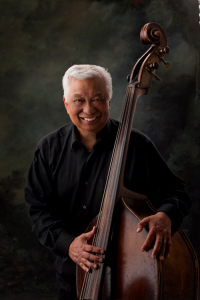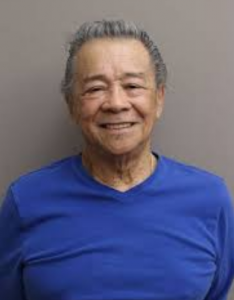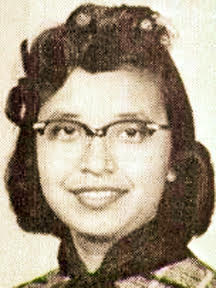PETER’S PINOY PATTER — JUNE 2020
Bridge Generation News
BG PERSONALITY OF THE MONTH, VINCE GOMEZ, 85:
 According to Mirriam-Webster Learner’s Dictionary, a Renaissance Man is defined as: A person who is interested in and knows a lot about many things; who has travelled the world, experienced its people; who is not afraid to be who he is and is comfortable in his own skin. One might define Vince as a modern-day Renaissance Man. He is artistically adept as a musician, equally skilled in symphonic and jazz music; an inspirational educator who integrates culturally relevance into his teaching; a world traveler; and good enough to play college basketball against two future professional Hall of Famers. Finally, Vince is comfortable in his own skin — an affable, unabashed Bridge Generation Filipino American, always eager to “talk stories” with his BG contemperaries.
According to Mirriam-Webster Learner’s Dictionary, a Renaissance Man is defined as: A person who is interested in and knows a lot about many things; who has travelled the world, experienced its people; who is not afraid to be who he is and is comfortable in his own skin. One might define Vince as a modern-day Renaissance Man. He is artistically adept as a musician, equally skilled in symphonic and jazz music; an inspirational educator who integrates culturally relevance into his teaching; a world traveler; and good enough to play college basketball against two future professional Hall of Famers. Finally, Vince is comfortable in his own skin — an affable, unabashed Bridge Generation Filipino American, always eager to “talk stories” with his BG contemperaries.
Coming into the world on Groundhog Day, February 2, 1935 in San Francisco, Vince was the only child of Filipino immigrants Vicente Gomez and Catalina Entero. When he was five years old his parents found him with a coat hanger mimicking a violin. A violinist (and eventually a music educator, symphony/chorale conductor, and bassist) was born! Violin lessons soon followed that were further honed through recitals, participation in orchestras at SF’s Galileo High School, College of Pacific where he graduated with honors with a Bachelors in Music in 1956, and the University of Hawaii where he received a Masters in 1964.
Vince was an innovative music instructor. Dismayed at the lack of boys’ participation in his high school mixed chorale, he volunteered to serve as a boys’ basketball coach. After providing “incentives” to join, the chorale soon had almost as many boys as girls! Similar was his approach to teaching music appreciation classes. In a 1975 Santa Cruz magazine interview Vince said, “I use music to eliminate stereotypes and prejudices in cultural differences. I am really pissed at the lack of multi-cultural music education in schools today. Until music educators really know how to define multi-cultural education, we will not be able to meet the needs of our so-called melting-pot society.”
A well-deserved reputation as a conductor led Vince to opportunities as a guest conductor up and down California, across the nation, and abroad to Central and South America and Asia. Most noteworthy was his 1982-81 trip to the Philippines. Ostensibly to gather research material, he still was able to conduct several symphony orchestras and a boys’ choir in Manila as well as organize and conduct the Cebu Symphony Orchestra.
Vince grew up when jazz was in its prime and began playing the stand-up bass with the help of noted jazz bassist, Ralph Pena. He was equally adept with jazz as with classical music and shared the stage with jazz icons Oscar Peterson, Sarah Vaughan, and the Hi-Lo’s. He accompanied Bridge Generation artists Josie Canion, Flip Nunez, Rudy Tenio, Mike Montano, and George Muribus.
Vince starred in basketball, beginning with the Galileo High School varsity in San Francisco. At College of Pacific, the 5’6” Vince played against the University of San Francisco’s nearly 7 foot center Bill Russell and 6’1’’ guard K.C. Jones, who both became professional basketball Hall of Famers. Today, his sports participation is spent largely as a “Ball Dude” with the San Francisco Giants. (The Giants’ Ball Dude/Dudette Program involves seniors in on-field action by having them toss foul balls to fans in the stands.)
Like his Bridge Generation contemporaries, Vince shares BG collective experiences. He too was discriminated in obtaining employment; his young family was denied housing. At the same time, he is proud of his generation and their accomplishments, particularly since they occurred before anti-discrimination legal remedies. Similarly, he takes great pride the Bridge Generation has emerged unscathed despite going through the Great Depression, World War II, and the Korean War………. A modern-day Renaissance Man indeed!
Did you Know?
Happily retired Linda (Birgonia) Alemania of Vallejo was the first Filipino American teacher hired by her hometown school district
Passings: Pastor Engkabo, Elsie Supat
 I was saddened by the death of longtime and dear friend, Pastor Engkabo, 89, on April 13. Pastor was two weeks younger than me at our respective births in 1930. We didn’t meet until 1945 — at a basketball game at Livingston High School. Pastor, a four-sport letterman during his Edison (Stockton) High School years, was playing for Edison. Vertically challenged me? I was in the stands. Since that cold winter day we’ve maintained a friendship which blossomed when we both settled in Sacramento in the 1950s. We became charter members of the Sacramento Filipino Youth Association, socialized frequently, and bowled in the Filipino Bowling League. An avid golfer, Pastor tried his best to join him on the golf course. He even bought me a 5-iron for my birthday. But I could never develop an interest in the sport.
I was saddened by the death of longtime and dear friend, Pastor Engkabo, 89, on April 13. Pastor was two weeks younger than me at our respective births in 1930. We didn’t meet until 1945 — at a basketball game at Livingston High School. Pastor, a four-sport letterman during his Edison (Stockton) High School years, was playing for Edison. Vertically challenged me? I was in the stands. Since that cold winter day we’ve maintained a friendship which blossomed when we both settled in Sacramento in the 1950s. We became charter members of the Sacramento Filipino Youth Association, socialized frequently, and bowled in the Filipino Bowling League. An avid golfer, Pastor tried his best to join him on the golf course. He even bought me a 5-iron for my birthday. But I could never develop an interest in the sport.
Like many Bridge Generation contemporaries, Pastor served in the Korean War as an infantryman and worked in the salmon canneries as an Alaskero. He had a varied career beginning with the restaurant business, 13 years in insurance, 5 years in construction, before becoming a real estate appraiser for 25 years. The quiet and committed Pastor was deeply involved in the Filipino Community — not just a member but an officer in the community’s many organizations.
Pastor was preceded in death by his wife of 52 years, Lorraine (Evangelista) Engkabo who passed away in 2005. He is survived by his children Sherina Paulson, Renee Deaton, Shelly Engkabo, Judith Engkabo, and Pastor Engkabo III in addition to 15 grandchildren, 25 great grandchildren, 6 siblings, and close friend Jean Campos.
 Elsie Supat, 79, of Livingston CA passed away on May 3 after battling renal failure. The daughter of one of the first Filipino families to settle in the Livingston/Delhi area, she spent virtually all of her life in the Central Valley.
Elsie Supat, 79, of Livingston CA passed away on May 3 after battling renal failure. The daughter of one of the first Filipino families to settle in the Livingston/Delhi area, she spent virtually all of her life in the Central Valley.
Musings
Disproportionate Impacts of COVID-19 on Persons of Color
(Ethnic data is not widely captured. Without a national data base, POC information is scattered or anecdotal.) The Navajo Nation has the third highest per capita infection rate of any state. Latinos, predominant in agriculture and in meat/poultry packing plants, are twice as likely to be infected. Media reports continue to show steep spikes in Filipino deaths. Asians are often blamed for the virus and subjected to increasing hate crimes, i.e. the Filipino male nurse in a New York subway who was called a “Chinaman” and severely beaten. Some good news: two Filipino Americans made national news for recovering from coronavirus after a lengthy hospitalization — Michael Flor of Seattle, 2 months; Maria Francisco of New York City, 1 plus month.
Other COVID-19 News
Most states reopened their economies in mid-May; few fully complied with the first phase of the federal Reopening Guidelines. Too many Americans responded by crowding into barbershops, salons, bars, retail stores, and beaches. Few wore masks or followed social distancing. At this writing, all 50 states have reopened but the situation remains essentially the same. Too many Americans continue to ignore the scientific community’s warning that failure to follow minimum mitigation practices will in result in a 2nd wave more deadly than the current crisis, perhaps as early as this summer. There continues to be a lack of national leadership; the president has left reopening decisions to state governors.
Your Blogger’s Musings
My positions in last month’s blog remain the same: (1) Quell the COVID-19 crisis first; public health will result in economic health. (2) Keep stay-at-home strategies in place; only reopen the economy when it is scientifically supported. I am appalled too many Americans ignored the advice of expert scientists. I am equally appalled too many Americans — some with guns — protested their 2-months home isolation in state capitals. Is it because Americans have been spoiled by decades of a steadily growing economy? Aren’t present-day Americans aware of 4-years of sacrifice by World War II Americans when families grew “Victory Gardens” in their back yards, children saved tin foil, everyone accepted rationing of food and gas — all for the common good, without protesting? Will Americans be more disciplined and follow science or will we be influenced by politics and immediate gratification? Memorial Day should be a test case.
Pinakbet — News Across America
Primary Results
Bobby Scott won reelection to Virginia’s 3rd Congressional District. A Democrat, he is the longest-serving member of Virginia’s congressional delegation. In Texas’ 23rd Congressional District, Gina Ortiz Jones won the Democratic nomination with 66% of the votes. Democrat TJ Cox — the first Filipino American from California to serve in Congress — will again face a Republican in the 21st District. In California Assembly District 18, Democratic incumbent Rob Bonta, the first Filipino American to serve in the Legislature, received a whopping 85% of the votes. In California Assembly District 53, Democrat Godfrey Santos Plata will be running in the general election. Todd Gloria topped the race for San Diego mayor and will compete against fellow councilmember Scott Sherman in a November runoff.
Fall of the I-Hotel
I highly recommend YouTube’s “How San Francisco Erased a Neighborhood”, a documentary on 1977’s violent evictions of Filipino elderly from San Francisco’s International Hotel in 1977. It is narrated by 1970s student activists Emile DeGuzman, former president of the I-Hotel Tenants Association, and Estella Habal, Professor Emeritus, San Jose State University.
###########
2 Comments
Shelley Gonzalez London
Thank you for sharing the video “How San Francisco Erased a Neighborhood”. The unfair, unjust, and inhumane way Filipinos were treated is so frustrating and sad. The faces of the Manongs bring tears whilst fueling a fire to protest against the powers that are supposed to protect us. Racism will never help our species progress. In light of the current political environment and BLM movement, Filipinos have our own story and history which is unheard and “invisible”, but our narrative is equally as important and a part of US History that needs to be taught and included in curriculum.
Peter Jamero
You’re welcome, Shelley, glad you learned another facet of the Filipino experience in America. My thanks for your own inspirational take on the video. You’re right — our history needs to be included in schools. Thanks to Assemblyman Rob Bonta for successfully pushing his bill mandating Filipino American history to be taught in public schools.